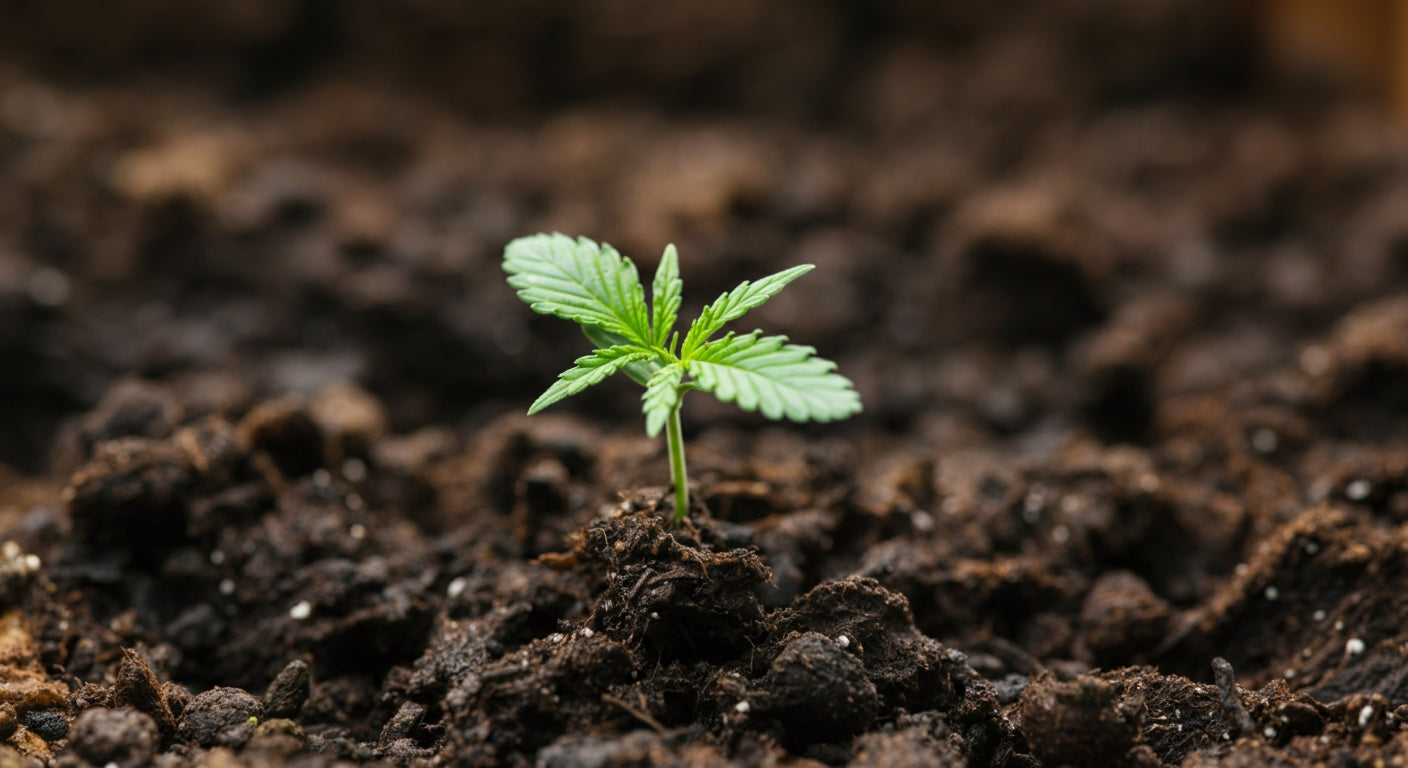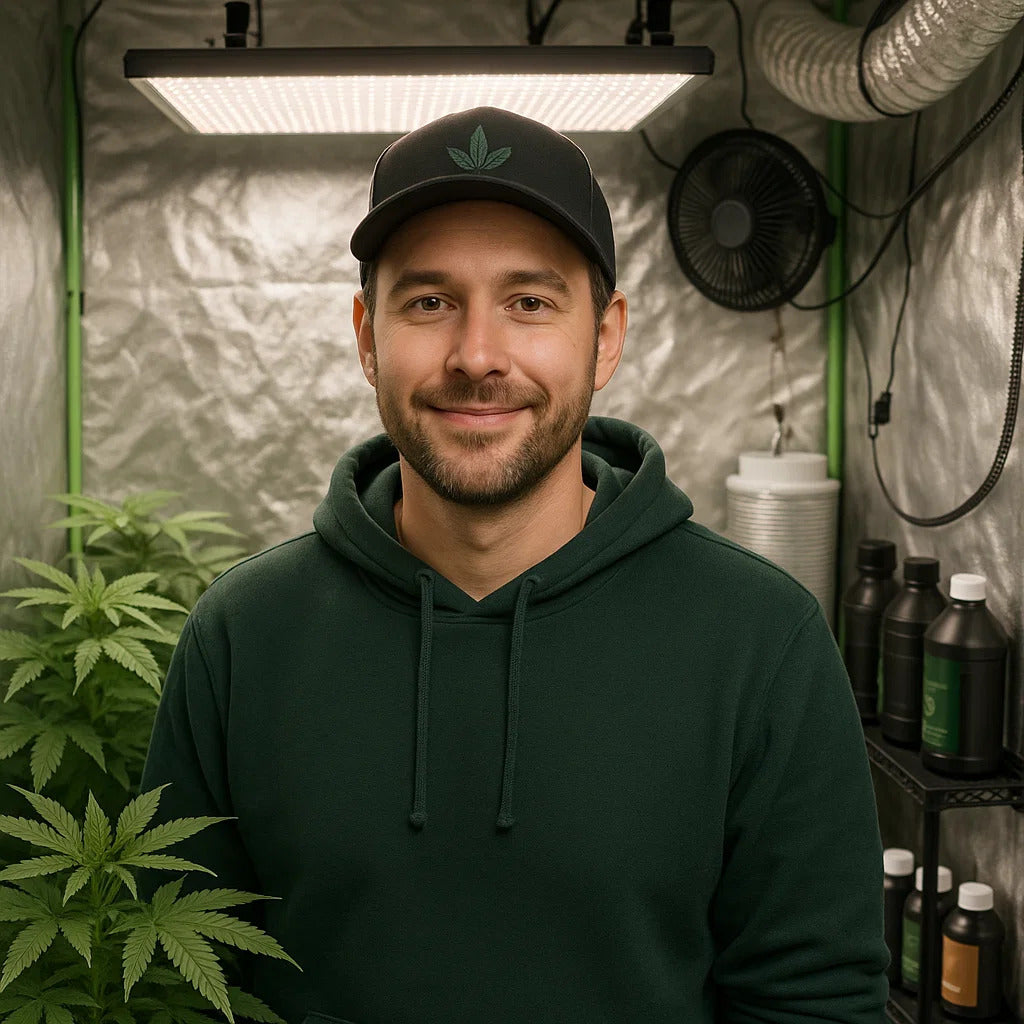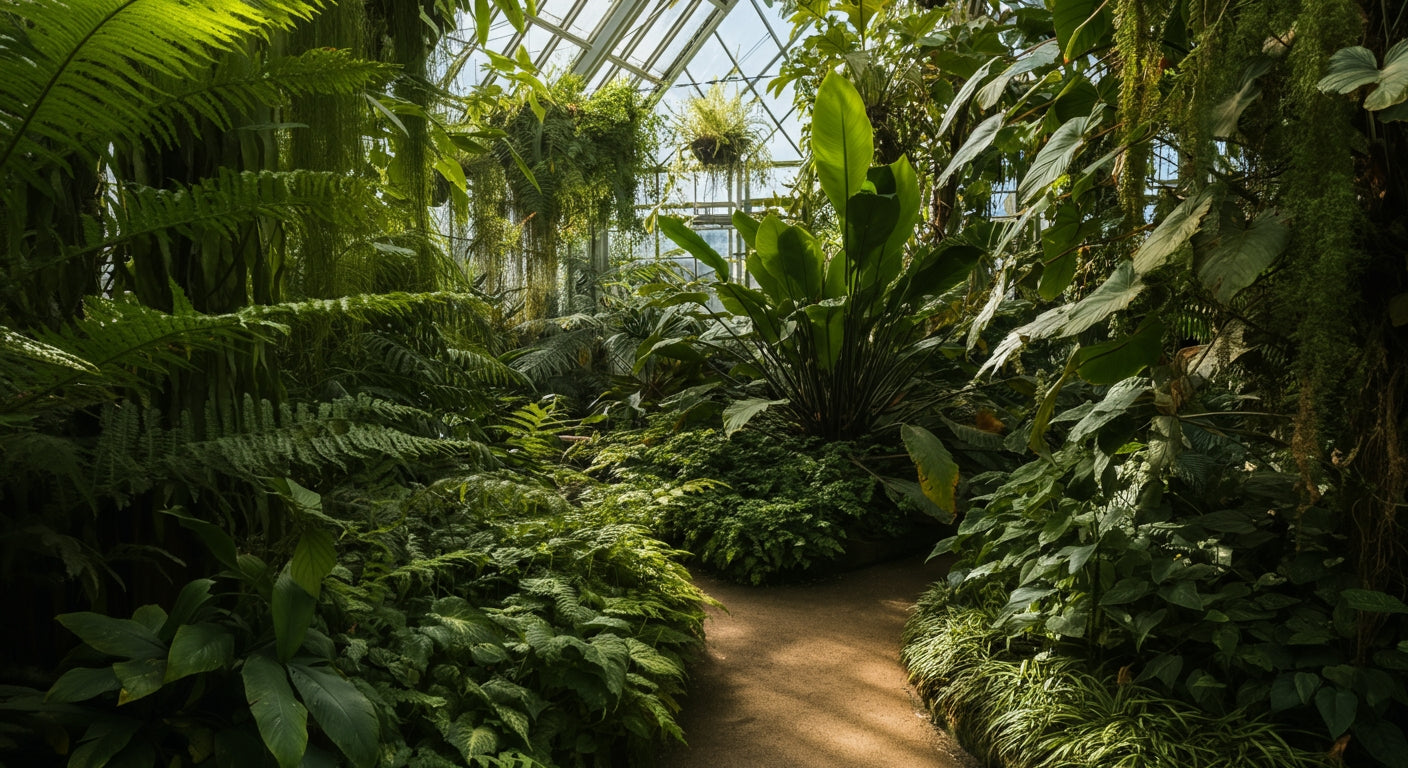
How to Grow Plant Seedlings: Your Complete Guide to Healthy Early Development
Seedlings represent the most critical and vulnerable stage of your plant's entire lifecycle. These first 2-4 weeks after germination determine whether your plants will develop into healthy, vigorous specimens or struggle with problems that affect their entire growing cycle. Proper seedling care requires precise environmental control, gentle handling, and understanding of their unique needs.
Many growers lose more plants during the seedling stage than any other phase. The combination of delicate root systems, sensitivity to environmental changes, and specific nutritional requirements makes this period challenging but absolutely crucial for long-term success.
This comprehensive guide covers everything you need to know about growing healthy seedlings, from the moment they emerge from soil through their transition to vigorous vegetative growth. With proper technique and controlled growing environments, you can achieve nearly 100% seedling survival rates.

Understanding Seedling Development
The Seedling Growth Timeline
Days 1-3 (Emergence):
- Cotyledons (seed leaves) emerge from soil
- Initial root system development
- Most vulnerable period for damping-off disease
- Rely entirely on seed's stored energy
Days 4-7 (Cotyledon Stage):
- Cotyledons open and begin photosynthesis
- First true leaves begin developing
- Root system expands rapidly
- Transition from seed nutrition to photosynthesis
Days 8-14 (First True Leaves):
- First serrated leaves appear
- Photosynthesis becomes primary energy source
- Root system establishes in growing medium
- Begin responding to light intensity changes
Days 15-28 (Established Seedling):
- Multiple sets of true leaves develop
- Stem thickness increases significantly
- Root system fills initial container
- Ready for transplanting and increased nutrients
Seedling Anatomy and Needs
Root System Development:
- Primary taproot extends downward
- Secondary roots branch horizontally
- Root hairs develop for nutrient absorption
- Extremely sensitive to overwatering and temperature
Above-Ground Growth:
- Cotyledons provide initial photosynthesis
- True leaves develop characteristic serrated edges
- Stem begins developing vascular system
- Internodal spacing indicates light adequacy
Understanding these developmental stages helps you provide appropriate care at each phase, ensuring healthy progression to the vegetative stage.
Creating the Perfect Seedling Environment
Temperature Control for Seedlings
Optimal Temperature Ranges:
- Air temperature: 70-75°F (21-24°C) consistently
- Soil temperature: 70-75°F for healthy root development
- Temperature stability: Avoid fluctuations greater than 5°F
- Day/night differential: Minimal variation during seedling stage
Temperature Management:
- Use heat mats under seed trays if needed
- Monitor with accurate thermometers
- Adjust ventilation to maintain stability
- Consider grow tent environmental control for consistency
Humidity Requirements
Ideal Humidity Levels:
- Relative humidity: 65-70% for optimal growth
- Too low: Causes stress and slowed growth
- Too high: Increases damping-off disease risk
- Gradual reduction: Slowly decrease as plants mature
Humidity Management Techniques:
- Use humidity domes for very young seedlings
- Mist around plants (not directly on leaves)
- Adjust ventilation to control moisture levels
- Monitor with digital hygrometers
Professional grow tent systems provide the precise environmental control essential for maintaining optimal seedling conditions.
Air Circulation and Ventilation
Gentle Airflow Benefits:
- Strengthens stem development
- Prevents stagnant air and mold issues
- Improves gas exchange for photosynthesis
- Reduces pest and disease pressure
Proper Air Movement:
- Use small oscillating fans on low speed
- Indirect airflow that gently moves leaves
- Avoid direct wind that causes stress
- Maintain fresh air exchange without drafts

Lighting for Seedlings
Light Requirements and Intensity
Optimal Light Conditions:
- Photoperiod: 18 hours on, 6 hours off
- Light intensity: 100-300 PPFD (much lower than mature plants)
- Light distance: 18-24 inches from LED lights
- Spectrum: Full spectrum or blue-heavy for vegetative growth
Common Lighting Mistakes:
- Too intense: Causes light burn and stunted growth
- Too close: Heat stress and leaf damage
- Inconsistent timing: Disrupts natural growth rhythms
- Poor spectrum: Inadequate development and stretching
LED Lighting for Seedlings
LED Advantages:
- Lower heat output reduces burning risk
- Precise spectrum control for optimal growth
- Energy efficient for continuous operation
- Dimmable options for gradual intensity increases
Light Management:
- Start with dimmed lights or increased distance
- Gradually increase intensity as plants mature
- Monitor for signs of light stress or deficiency
- Use timers for consistent photoperiods
Recognizing Light-Related Problems
Light Burn Symptoms:
- Yellow or white patches on leaves
- Crispy, dry leaf edges
- Stunted growth despite adequate nutrition
- Leaves curling upward or downward
Insufficient Light Symptoms:
- Excessive stretching (tall, weak stems)
- Pale green or yellow coloration
- Slow development of true leaves
- Weak, spindly growth pattern
Watering and Feeding Seedlings
Proper Watering Techniques
Seedling Watering Principles:
- Less is more: Overwatering kills more seedlings than underwatering
- Water around, not on: Avoid direct stem contact
- Check soil moisture: Top inch should dry between waterings
- Use appropriate tools: Spray bottles or gentle watering cans
Watering Schedule:
- Days 1-7: Minimal watering, rely on initial soil moisture
- Days 8-14: Light watering every 2-3 days
- Days 15-28: Regular watering as soil dries
- Always: Check soil moisture before watering
Water Quality:
- pH level: 6.0-7.0 for soil, 5.5-6.5 for soilless
- EC/PPM: Pure water initially, low EC as plants mature
- Temperature: Room temperature water (65-75°F)
- Quality: Filtered or distilled water preferred
Nutrient Management for Seedlings
Early Nutrition Strategy:
- Weeks 1-2: No additional nutrients needed
- Quality potting soil: Contains sufficient early nutrition
- Organic amendments: Slow-release nutrients work well
- Avoid synthetic nutrients: Can burn delicate roots
When to Start Feeding:
- First true leaves: Earliest time to consider nutrients
- Healthy appearance: Only if plants show nutrient deficiency
- Dilute strength: Start with 1/4 recommended dosage
- Gradual increase: Slowly build up nutrient levels
Nutrient Deficiency Signs:
- Nitrogen deficiency: Yellowing of cotyledons (often normal)
- Phosphorus deficiency: Purple stems or dark leaves
- General deficiency: Slow growth or pale coloration
- pH lockout: Nutrients present but unavailable
Growing Medium Selection
Seedling-Friendly Media:
- Seed starting mix: Light, well-draining, low nutrients
- Coco coir blend: Excellent drainage and root development
- Perlite-rich soil: Improved aeration and drainage
- Organic compost: Provides gentle, slow-release nutrition
Media Characteristics:
- Good drainage: Prevents root rot and overwatering
- Appropriate pH: Buffered to optimal range
- Light texture: Easy root penetration
- Sterile: Free from pests and diseases
Common Seedling Problems and Solutions
Damping-Off Disease
Symptoms:
- Seedlings fall over at soil line
- Dark, constricted stem near soil surface
- Rapid progression affecting multiple plants
- Fuzzy growth around affected areas
Prevention and Treatment:
- Improve air circulation: Reduce humidity and stagnant air
- Reduce watering frequency: Allow soil to dry between waterings
- Use sterile growing medium: Prevent fungal contamination
- Maintain proper temperature: Avoid cool, wet conditions
Nutrient Burn
Symptoms:
- Brown, crispy leaf tips
- Yellowing or browning of leaf edges
- Stunted growth despite adequate light
- Dark green leaves with burned edges
Treatment:
- Flush with plain water: Remove excess nutrients
- Reduce feeding strength: Use more diluted solutions
- Improve drainage: Prevent nutrient buildup
- Monitor pH: Ensure proper nutrient uptake
Stretching and Weak Growth
Causes:
- Insufficient light intensity or duration
- Excessive heat causing elongation
- Poor air circulation
- Genetic factors in some strains
Solutions:
- Increase light intensity: Gradually move lights closer
- Improve air circulation: Strengthen stems naturally
- Reduce temperature: Cooler conditions reduce stretching
- Provide support: Stake weak seedlings if necessary
Transplanting Seedlings
When to Transplant
Readiness Indicators:
- 2-4 sets of true leaves: Established photosynthesis
- Visible roots: Roots appearing at drainage holes
- Steady growth: Consistent daily development
- Strong stems: Able to support plant weight
Timing Considerations:
- Age: Typically 2-4 weeks after germination
- Size: 3-6 inches tall with robust growth
- Container size: Roots filling current container
- Growth rate: Accelerating development indicates readiness
Transplanting Technique
Pre-Transplant Preparation:
- Water seedlings: Easier root ball removal
- Prepare new containers: Larger pots with quality growing medium
- Sterilize tools: Prevent disease transmission
- Plan timing: Transplant before lights turn on
Transplanting Process:
- Gentle removal: Support root ball, avoid stem handling
- Inspect roots: Check for healthy white root development
- Proper depth: Plant at same soil level as previous container
- Firm gently: Ensure good soil contact without compaction
- Water carefully: Settle soil without overwatering
Post-Transplant Care
Recovery Period:
- Reduced light intensity: Lower stress during adjustment
- Stable environment: Avoid temperature or humidity changes
- Minimal handling: Allow roots to establish in new medium
- Monitor closely: Watch for transplant shock symptoms
Signs of Successful Transplant:
- New growth: Fresh leaves appearing within days
- Strong stems: Continued structural development
- Root expansion: Roots growing into new medium
- Healthy appearance: Vibrant green coloration
Advanced Seedling Techniques
Seedling Training and Manipulation
Early Training Options:
- Gentle bending: Encourage bushier growth
- Pinching: Remove growth tips to promote branching
- Lst preparation: Set foundation for future training
- Selective pruning: Remove weak or damaged growth
Training Timing:
- Wait for establishment: At least 4-6 true leaves
- Gradual implementation: Avoid shocking young plants
- Monitor response: Adjust techniques based on plant reaction
- Prepare for vegetative training: Set up for future techniques
Optimizing Seedling Development
Growth Acceleration:
- CO2 supplementation: Enhance photosynthesis rates
- Optimal VPD: Balance temperature and humidity perfectly
- Spectrum optimization: Adjust light spectrum for growth phases
- Root stimulants: Organic supplements for root development
Quality Control:
- Selection criteria: Choose strongest seedlings for continued growth
- Health monitoring: Regular inspection for problems
- Documentation: Record growth rates and characteristics
- Environmental logging: Track conditions for optimization
FAQ Section
Q: How long do seedlings take to establish? A: Seedlings typically take 2-4 weeks to establish, depending on genetics and growing conditions. They're considered established when they have 2-4 sets of true leaves and are actively growing. This is when they can handle transplanting and slightly increased nutrients.
Q: Why do my seedlings keep falling over? A: Seedlings falling over is usually caused by damping-off disease (fungal infection) or weak stems from insufficient light. Improve air circulation, reduce watering frequency, ensure adequate lighting, and consider using a small fan to strengthen stems naturally.
Q: When should I start feeding nutrients to seedlings? A: Wait until seedlings have their first set of true leaves (typically 1-2 weeks after germination) before considering nutrients. Quality potting soil contains sufficient nutrition for early growth. Start with very diluted nutrients (1/4 strength) and increase gradually.
Q: What's the best temperature for seedlings? A: Maintain 70-75°F consistently for optimal seedling growth. Avoid temperature fluctuations greater than 5°F, and keep soil temperature in the same range. Use heat mats if necessary to maintain proper root zone temperatures.
Q: How much light do seedlings need? A: Seedlings need much less light than mature plants - about 100-300 PPFD with an 18/6 light schedule. Keep LED lights 18-24 inches away initially and gradually increase intensity as plants mature. Too much light causes stunted growth and burning.
Featured Snippet Summary
How to grow seedlings: Maintain 70-75°F temperature, 65-70% humidity, and 18/6 lighting at 100-300 PPFD. Water gently when soil surface dries, avoid nutrients for first 2 weeks, ensure gentle air circulation. Transplant when seedlings have 2-4 true leaves (2-4 weeks after germination). Common problems include damping-off disease and overwatering.
Build the Perfect Foundation for Success
Seedlings require the most precise environmental control of any growth stage - even small variations in temperature, humidity, or lighting can mean the difference between thriving plants and costly failures. The investment you make in proper seedling care pays dividends throughout the entire growing cycle.
Gorilla Grow Tents provide the environmental stability essential for seedling success. With superior insulation, precise ventilation control, and adjustable height systems, you can maintain the consistent conditions that fragile seedlings demand while eliminating the environmental fluctuations that cause most seedling losses.
The controlled environment of a professional grow tent system allows you to dial in the perfect temperature, humidity, and airflow that seedlings need to develop strong root systems and healthy growth patterns. This foundation sets the stage for vigorous vegetative growth and ultimately, exceptional harvests.
Whether you're starting with a compact 2x2 setup for personal cultivation or planning a larger seedling operation, having professional-grade environmental control eliminates the guesswork and inconsistency that plague many seedling growers.
Don't let seedling stage failures derail your growing success. Explore our complete growing systems and discover why serious growers trust Gorilla for the most critical phase of cultivation.
Ready to master every aspect of early plant development? Learn about creating optimal growing environments and environmental control techniques that ensure seedling success from day one.

Lena Myles
I'm a mushroom enthusiast and home cook based in Oregon. I'm passionate about foraging and creating fungi-focused recipes, especially delicious, plant-based dishes using gourmet mushrooms like trumpet, shiitake, and oyster. When I’m not in the kitchen, you’ll usually find me wandering the woods in search of new wild flavors.

